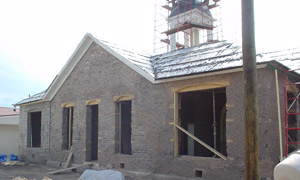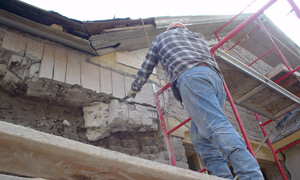The Costilla County Courthouse - An Early Jackalope
Ed Crocker
Years ago while serving as an advisor to the archdiocese for the plasters on the Santuario de Guadalupe here in Santa Fe, I argued strongly for retaining the beautiful (and in my view acceptably weathered) mud plaster. When it became clear that the prejudice against mud was simply not going to be overcome, I made the argument for lime plaster. This they agreed to try, but the contractor was stubbornly unwilling to accept such a seemingly archaic technology into his repertoire. He made every effort to advance the cause of failure, was spectacularly successful, and the building was finally encased in elastomeric (often called "synthetic") stucco.
It was, and remains, a big disappointment to me that owners, architects and contractors steadfastly refuse to look at buildings as systems in which each component needs to work compatibly with the others. Overlaying soft earthen materials with rigid concrete and then slavering the whole thing with a petrochemical derivative is to take a building with an admirable pedigree and render it neither fish nor fowl.
Until recently I assumed that this Frankensteinian crossbreeding of components was a modern phenomenon dating to the post-World War II era when new and "advanced" materials became commonly available. But the assumption was wrong.
In the fall of 2004 we were awarded the contract to stabilize and restore the exterior of the Costilla County Courthouse in San Luis, Colorado. One of our first tasks was to assess existing conditions, determine what materials had been used during the various campaigns of remodeling and repair and, using that information, make recommendations for the restoration. Our findings were surprising and iconoclastic.


The Courthouse was built ca. 1886. It is adobe on a massive fieldstone footing that we had thought to be dry-laid, that is, without mortar. Once exposed, however, we found that the stone had been laid using Portland cement. In 1886? A very rare occurrence as Portland was not manufactured anywhere in the region until well into the next century and therefore was usually prohibitively expensive to freight in. Further findings were even more surprising. The adobes in the courthouse are not the usual size for this area; instead of 10-inches by fourteen by four, the norm, they are the approximate size of a standard fired brick. And, they are laid in coursework with intermittent headers (bricks laid across the long axis of the wall) punctuating the stringers (those laid along the axis).
The builders of the courthouse, we surmise, were (as was the Portland cement) imported. The evidence leads us to think that masons from the East or Mid-west came to San Luis to build the courthouse. They wanted familiar materials and got them to some degree. Bringing in bricks, or setting up a kiln to make them regionally, just didn't happen. Instead they did the next best thing; they made adobes that they could lay like bricks.
When the walls were up, the imported masons applied their imported plaster. In keeping with the technology of fired brick buildings, they plastered the walls using Portland cement without lathing. A photograph from the 1890s shows the plaster coming off in sheets. Sometime during the first decade or so of the 20th century when wire nails became readily available, someone revisited the plaster problem. They drove nails through what remained of the original plaster, left the heads standing proud of the surface as a mechanical attachment device for the new render, and applied a new finish. Again, it was Portland-based; we know this because we have verified the composition using X-ray diffraction technology.
The mixing of dissimilar materials, like mismatching tissue in an organ transplant, leads to rejection of the offending component or failure of the entire system. The Santuario de Guadalupe is slowly deteriorating, you can be sure, behind its impermeable plastic. In San Luis we are faced with a restoration principle that compels us to respect original materials and the technologies employed by the builders while knowing full well that such respect may not be the best thing for the structure.
In 1886 the alien masons in Costilla County found themselves in wild and unfamiliar surroundings. They worked to adjust and manipulate what they could to accommodate their skills and in the process crossed, as it were, a jackrabbit and an antelope. Now we are faced with finding a way to sustain that strange, unnatural species.

